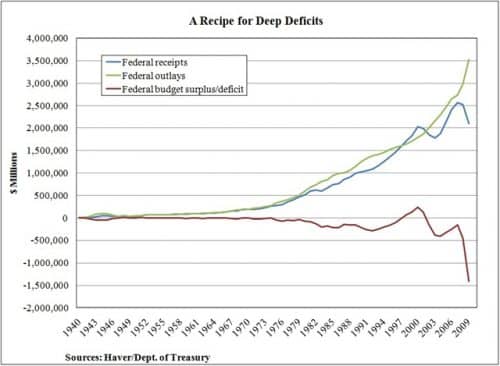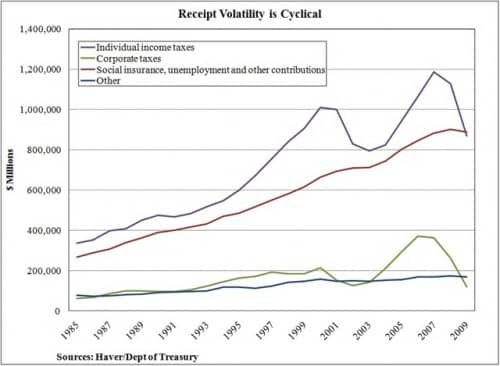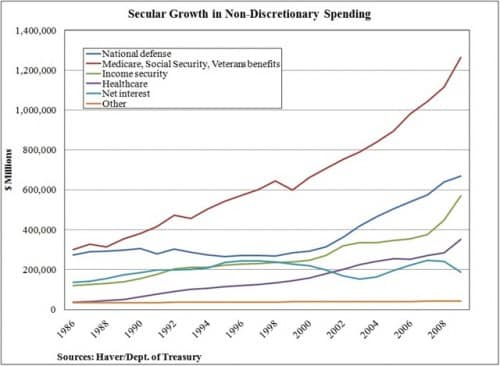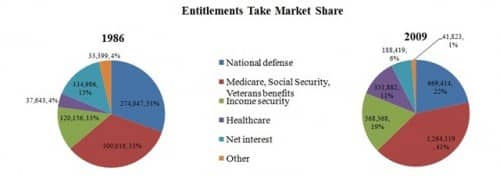Receipts and Outlays
The chatter is deafening. The results of the primary elections this week, with the strong anti-incumbent fervor and the surprising showing by the Tea Party, has Beltway pundits all aflutter about the possible shape of Washington politics and power come November. We know from our own experience that the future is impossible to predict, so we won’t hazard a guess about the outcome, but the consensus seems to be that the Democrats will lose control of the House and retain a slim majority in the Senate.
The loudest chatter surrounding the election frenzy involves taxes and spending, or, as they are known in government budget-speak, receipts and outlays. Will the Bush tax cuts be made permanent? And if so, for whom? Will spending cuts be made or will there be more stimulus spending? For what it’s worth (and it may not be worth much given the myriad assumptions that go into a variable-laden econometric model), the nonpartisan Congressional Budget Office says that a permanent extension of the Bush tax regime would increase deficits by a cumulative $3.9 trillion over the next decade. The op-ed page of the Wall Street Journal took up the argument this week with a five-handed article (by George Shultz, Michael Boskin, John Cogan, Allan Meltzer and John Taylor) called “Principles for Economic Revival,” which focuses primarily on three proposed structural changes to the Federal income statement: 1) avoid tax increases, 2) reduce government spending and 3) modify the growth of Social Security and health-care entitlements. Without these changes, the authors assert, our nation is “on a destructive path.”
The piece was provocative but lacking in good graphs, so we pulled together a few to help put in context the challenges facing any policymaker who tries to thread the needle with those three principles. The major takeaway that we offer from this suite of graphs is that the budget problems are both cyclical and structural, and it is important to separate the two when formulating policy. To begin, we look at the big picture, which is the overall budget situation. What is clear is that the deepening deficit is a function of both falling receipts and the increase in the rate of spending growth.
What are the components of government receipts? Largely individual income taxes (42% of all receipts in 2009) and contributions to Social Security, unemployment insurance and other retirement plans (43%). Corporate income taxes only constituted 6% of total receipts in 2009. The net decline in receipts from the peak in 2007 to 2009 has been about $560 billion or 21% from $2.6 trillion to $2.04 trillion, with individual income taxes falling $318 billion or 27% and corporate income taxes falling $242 billion or a staggering 66%. Two observations: These reduced receipts have come with largely the exact same tax structure in place for individuals and corporations, and the same pattern was observed in the wake of the 2001 recession. It would appear that an improving economy—which would bring more jobs, higher incomes and corporate profitability—works very well at raising tax receipts.
What about outlays? This is where it gets challenging for anyone looking to seriously take on the problem of structural reform of Federal finances, because the increases in outlays, with some exceptions, such as the growth in retirement and disability insurance (excluding Social Security), unemployment compensation, housing and food assistance (together, “income security” in the graph below) are secular.
The shifting proportion of government spending is clear to see on the graph as we see the growth in entitlements (Medicare, Social Security and veterans benefits). Since 1986, the share has shifted significantly.
From 1986 to 2009, total government outlays have increased 254%. Over that same period, national defense has grown just 144% while entitlements have grown 321% and healthcare has grown a staggering 835%. (Despite more than quadrupling Federal debt outstanding, net interest expense has barely budged thanks to lower interest rates.) Income security has grown quickly of late, but this is largely a cyclical function of benefits extension to a growing pool of recipients, similar to what we have seen in other economic downturns. In 2009, income security totaled $568 billion, up almost $200 billion from 2007. (Through August 2010, income security spending is now up to $664 billion on an annualized basis.)
If policymakers are looking to reduce or eliminate the deficit through spending cuts, the problem is that the amount of discretionary spending that is ripe for cutting is a relatively small portion of the pot. But we also think that a cyclical recovery will go some way to cutting into the $1.4 trillion deficit. A rebound to cyclical highs could result in tax receipts increasing by $500 billion or so, and reduced income security payments could cut outlays by $200 billion or so. These are speculations, of course, based on historical numbers, but even this only gets us halfway there. If we assume for the moment that there is no discretion to cut Medicare, Social Security, healthcare and net interest payments, and further assuming the cyclical drop in income security, there is only about $700 billion of outlays that can be attacked—defense and other spending. So without changing non-discretionary items, it is hard to see a path to even coming close to a balanced budget.




Comments are closed.